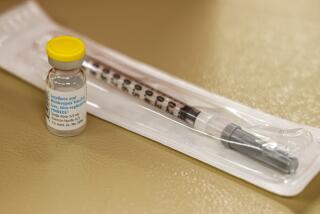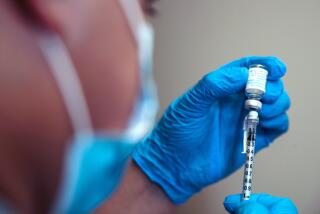Anthrax Vaccine May Be Offered to Wider Group
- Share via
WASHINGTON — In a move that would mark a shift in public health policy, the anthrax vaccine could be made available as soon as this week to people who might have been exposed to a large number of the deadly spores, top federal health officials said Saturday.
A decision on whether to release the vaccine for such voluntary treatment will likely be made in the next couple days by Health and Human Services Secretary Tommy G. Thompson.
At one point, more than 32,000 Americans were taking antibiotics to combat possible exposure to the bioterrorist attack launched by mail more than three months ago, although far fewer fall into the high-risk category to be eligible for the vaccine. Health officials are worried that the recommended 60-day drug regimen might not wipe out all of the spores in those who were heavily exposed.
If Thompson gives the go-ahead, it would allow a new, experimental use of a vaccine that previously has been available only as a preventive measure for military troops and laboratory workers. Those qualified to receive the vaccine would have to consult with a doctor and give informed consent before receiving any doses.
Researchers believe, based on animal studies, that once an individual is vaccinated, he or she would be protected from infection by spores lingering in their lungs. The person would continue to take antibiotics during the vaccination process, which takes four weeks.
Concern about the safety of the vaccine, which some military personnel have refused under threat of discharge, is likely to be an issue if it is made more widely available.
The only U.S. maker, Michigan-based BioPort Inc., currently cannot ship doses because federal inspections have turned up various deficiencies in quality control and manufacturing at the plant.
The Defense Department has made available 220,000 doses of the vaccine to the health department, but only 10,000 are readily usable. The remaining doses didn’t meet production standards; while considered safe and effective, they can only be used in an emergency.
Wider access to the vaccine is being contemplated because health experts are alarmed by even the scant research that exists on the rare disease. The matter was debated in Washington on Saturday by the nation’s top health officials and anthrax researchers.
Anthrax has killed five people and sickened at least 13 others since letters were mailed to media outlets and Capitol Hill in September and October. The attack has baffled investigators, who have made little progress in finding either a suspect or source of the bacteria used.
There have been widespread public health implications, with top federal officials repeatedly revising assessments of who is at risk. Such ongoing concerns have led several private researchers, as well as local and state public health officials, to call for wider access to the vaccine.
Other options are extending use of antibiotics for an additional 30 days or closely monitoring those in the high-risk group for signs of illness after they stop taking antibiotics. About 3,000 mail workers and Capitol Hill staff members would fall into the high-risk category.
So far, no one who has taken the precautionary antibiotics has contracted anthrax, a “very promising” sign, health officials said.
Antibiotics’ Ability to Protect Discussed
But the officials remain troubled by studies that demonstrate spores can remain dormant in the lungs for a long time.
Studies discussed at Saturday’s meeting at the National Academy of Sciences, attended by many of the early U.S. pioneers of anthrax study, show antibiotics do not provide protection beyond their use.
Anthrax has developed in animals as long as 98 days after initial exposure, even after a course of antibiotic treatment. An outbreak in the Soviet Union in the 1970s included a victim who became ill 43 days after being exposed.
Furthermore, antibiotics alone provide no protection for additional exposures to the bacteria, while animals that were vaccinated survived later exposures.
Meanwhile, new tests on the release of anthrax-like powder from a sealed envelope indicate a far greater exposure risk than initially believed. The unpublished tests, conducted in Canada and cited extensively at Saturday’s meeting, found that 1 gram of fine powder similar to that used in the U.S. mail attacks expelled between 480 and 3,080 lethal doses of anthrax when the envelope was opened.
A lethal dose is considered to be 8,000 to 10,000 spores, based on animal research. But health officials, especially in light of the inhalation anthrax deaths of two women with no known exposure to the bacteria-filled letters, have said it is possible that some people could be sickened by far fewer spores.
Investigators believe a letter sent to Senate Majority Leader Tom Daschle (D-S.D.) contained about 2 grams of powder. The letter was opened Oct. 15 by an aide in Daschle’s Hart Senate Office Building suite; 70 staff members there are considered to be at very high risk, said John Eisold, the Capitol physician.
Eisold said an emergency plan drafted for the Capitol about a year ago--and revised two weeks before the Daschle letter was opened--called for vaccinations in addition to antibiotics in the event of an anthrax attack.
“Shortly after the incident, I made preparations to ask for the vaccine,” Eisold said. “I was asked to review my approach after it became clear I would be tied at the hip with the civilian public health response.”
Eisold said he was persuaded at the time to hold off on vaccines because of concerns about supplies and the wider public health implications. But he said new evidence, including the Canadian envelope study, has “strengthened my resolve that I was concerned about people under my care.”
Some workers in Daschle’s office, one presenter pointed out, had more anthrax spores in their nose than the quantity that led entire buildings to be shut down.
Dr. Ivan Walks, Washington’s chief health officer, said Saturday that he believed anything offered to Capitol Hill workers must also be made available to postal workers. An underestimation of the danger of the anthrax contained in the letters mailed to Washington slowed treatment of area postal workers and led many to angrily raise questions about unequal treatment.
Two mail workers died of inhalation anthrax before postal employees at the facility where the Daschle letter was processed were offered anti-anthrax drugs.
Officials who set U.S. health policy concede that animal research conducted so far--using a wet aerosol form of the bacteria--may underestimate the risk posed by the fine dry powder found in the letters sent to Washington, D.C.
“There is a great concern about the differences,” said Dr. D.A. Henderson, director of public health preparedness for the Department of Health and Human Services, after leading Saturday’s meeting. “I think we’d all like to see experiments that gave us better answers.”
More to Read
Sign up for Essential California
The most important California stories and recommendations in your inbox every morning.
You may occasionally receive promotional content from the Los Angeles Times.














